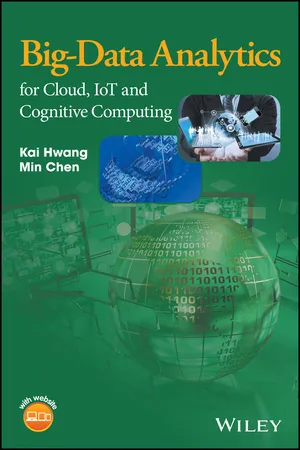
- English
- ePUB (mobile friendly)
- Available on iOS & Android
About this book
The definitive guide to successfully integrating social, mobile, Big-Data analytics, cloud and IoT principles and technologies
The main goal of this book is to spur the development of effective big-data computing operations on smart clouds that are fully supported by IoT sensing, machine learning and analytics systems. To that end, the authors draw upon their original research and proven track record in the field to describe a practical approach integrating big-data theories, cloud design principles, Internet of Things (IoT) sensing, machine learning, data analytics and Hadoop and Spark programming.
Part 1 focuses on data science, the roles of clouds and IoT devices and frameworks for big-data computing. Big data analytics and cognitive machine learning, as well as cloud architecture, IoT and cognitive systems are explored, and mobile cloud-IoT-interaction frameworks are illustrated with concrete system design examples. Part 2 is devoted to the principles of and algorithms for machine learning, data analytics and deep learning in big data applications. Part 3 concentrates on cloud programming software libraries from MapReduce to Hadoop, Spark and TensorFlow and describes business, educational, healthcare and social media applications for those tools.
- The first book describing a practical approach to integrating social, mobile, analytics, cloud and IoT (SMACT) principles and technologies
- Covers theory and computing techniques and technologies, making it suitable for use in both computer science and electrical engineering programs
- Offers an extremely well-informed vision of future intelligent and cognitive computing environments integrating SMACT technologies
- Fully illustrated throughout with examples, figures and approximately 150 problems to support and reinforce learning
- Features a companion website with an instructor manual and PowerPoint slides www.wiley.com/go/hwangIOT
Big-Data Analytics for Cloud, IoT and Cognitive Computing satisfies the demand among university faculty and students for cutting-edge information on emerging intelligent and cognitive computing systems and technologies. Professionals working in data science, cloud computing and IoT applications will also find this book to be an extremely useful working resource.
Frequently asked questions
- Essential is ideal for learners and professionals who enjoy exploring a wide range of subjects. Access the Essential Library with 800,000+ trusted titles and best-sellers across business, personal growth, and the humanities. Includes unlimited reading time and Standard Read Aloud voice.
- Complete: Perfect for advanced learners and researchers needing full, unrestricted access. Unlock 1.4M+ books across hundreds of subjects, including academic and specialized titles. The Complete Plan also includes advanced features like Premium Read Aloud and Research Assistant.
Please note we cannot support devices running on iOS 13 and Android 7 or earlier. Learn more about using the app.
Information
Part 1
Big Data, Clouds and Internet of Things
1
Big Data Science and Machine Intelligence
CHAPTER OUTLINE
- 1.1 Enabling Technologies for Big Data Computing
- 1.1.1 Data Science and Related Disciplines
- 1.1.2 Emerging Technologies in the Next Decade
- 1.1.3 Interactive SMACT Technologies
- 1.2 Social-Media, Mobile Networks and Cloud Computing
- 1.2.1 Social Networks and Web Service Sites
- 1.2.2 Mobile Cellular Core Networks
- 1.2.3 Mobile Devices and Internet Edge Networks
- 1.2.4 Mobile Cloud Computing Infrastructure
- 1.3 Big Data Acquisition and Analytics Evolution
- 1.3.1 Big Data Value Chain Extracted from Massive Data
- 1.3.2 Data Quality Control, Representation and Database Models
- 1.3.3 Big Data Acquisition and Preprocessing
- 1.3.4 Evolving Data Analytics over the Clouds
- 1.4 Machine Intelligence and Big Data Applications
- 1.4.1 Data Mining and Machine Learning
- 1.4.2 Big Data Applications – An Overview
- 1.4.3 Cognitive Computing – An Introduction
- 1.5 Conclusions
1.1 Enabling Technologies for Big Data Computing
1.1.1 Data Science and Related Disciplines


Table of contents
- Cover
- Title Page
- Copyright
- About the Authors
- Preface
- About the Companion Website
- Part 1 Big Data, Clouds and Internet of Things
- Part 2 Machine Learning and Deep Learning Algorithms
- Part 3 Big Data Analytics for Health-Care and Cognitive Learning
- Index
- EULA